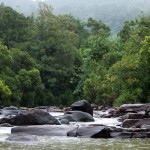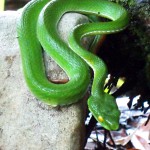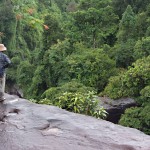The brief from The Advisor was, well, brief: ‘Go into the jungle and report on the efforts of a local community to establish an ecotourism project.’ So with the generous Advisor stipend – ‘All the back copies you can eat’ – I made a plan.
Eve of departure and the intention for a quiet night is scuttled by the return of the Cambodian Space Project to Equinox. I join the masses, with the band’s infectious energy inspiring a packed crowd to sweat-up the ceilings and raise Marco’s bar take for the night.
Mid-set I am introduced to Bryan, a Cambodia ‘newbie’ and photographer fresh out of Seoul and a K-pop photo shoot (best quip: “synchronised fascism with a dance beat”). He has heard about the trip and is keen, in his words, ‘to go into the Cambodia bush’. Wishing to avoid confusion, I point out that the trip has nothing to do with Street 136. “Sure,” replies Bryan, looking mildly confused. “Of course, the forest. Like, you know, the jungle! Right?”
OK, then. Satisfied that there have been no misunderstandings, ‘You will need supplies: a hammock, mossie net and bug juice. Oh, and some cheap perfume.’ Bryan, the uncertainty on his face giving way to trepidation: “Cheap perfume?” ‘You’ll see,’ I reply with a smile. ‘7 am then, bright and sharp,’ as I turn around and head back towards the bar.
EARLY START
It’s way too early for a Sunday when the alarm goes off. I stagger, stumble and slumber my way through a shower, breakfast and coffee, before heading down the stairs to the street corner and our pick-up.
I start to focus. There’s some strange dude in what looks to be a safari suit (think Roger Moore in his finest Live And Let Die guise), with various gadgets and gizmos – camera and lens cases, insect repellent, sunscreen – poking up and hanging from various pockets.
It’s Bryan!
He resembles an exploding magician, with different ‘tricks’ bursting from his pockets, while I notice a price-tag swinging from his neck. ‘Nice suit,’ I remark as I saunter up beside him. “Like it? Bought it in Tokyo last month; thought it would be perfect for this gig.”
‘Hmmm,’ I respond, looking down at my battered jeans, stained t-shirt and ripped cap. ‘I feel underdressed’. Bryan smiles. I think he’s pleased with himself.
“So ,where’s the ride?” He surveys the street around us. ‘Right behind you,’ I announce as I bend down to pick-up my pack. ‘Time to go.’
A large 4WD pulls up alongside us, the Morodok logo fixed prominently on its passenger-side door. A Cambodia-registered NGO, with a background of work in the Sre Ambel district in southern Cambodia, Morodok will be the sponsor of this trip.
The organisation had approached me a week earlier after one of their village partners, a community forest group, expressed an interest in developing an ecotourism enterprise. With some background in this area, the Morodok team believed I could offer some insights for the development of their strategy.
Having also previously worked in Sre Ambel in the mid-2000s, for me the trip promised to be a homecoming of sorts and offers a chance to catch-up with some old forest friends.
For Bryan, looking as excited as a Labrador at a school picnic, it promises to be, at the very least, an education.
SRE AMBEL
Sre Ambel, a town and a district, lies at the head of Kampong Som Bay and, depending on who you ask, means either ‘salt field’ or ‘salt woman’. The town itself is fairly nondescript. In the early 1990s the Khmer Rouge drifted in and out of the Elephant Hills at will, periodically ambushing and attacking government patrols and private vehicles.
This culminated in 1994 with the kidnapping of a French couple and a New Zealander at the village of Chamkar Luang, at the turnoff on Route 4 to Sre Ambel. A ransom was demanded, requests for the victims’ safe return made, but all to no avail; their bodies were found weeks later in shallow graves.
Later, spurred on by anarchic days of uncontrolled logging, Sre Ambel was known for its long line of brothels, which stretched up the hill towards its wet market. These and much of the town’s economic life evaporated in 2002 following the suspension of the concessions that had driven the timber trade.
What makes Sre Ambel a place of note today is its position as a gateway to the Kampong Som Valley. Here, a river of the same name snakes and forks its way deep into the Elephant Hills.
The hills, a continuation of the Cardamom Range and its expanse of tropical rainforest, are home to some of the Kingdom’s rarest wildlife, including the black and Malaysian sun bear, beady-eyed mongoose, fishing cat, leopard, deer, wild boar, great hornbill and unsurprisingly, given their name, the occasional elephant. Unfortunately, if any tigers remain, they are probably very lonely.
The waterways and trapeangs (‘small lakes’) also hold two of Cambodia’s rarest creatures, the Siamese crocodile and the Royal turtle. The latter was believed extinct until rediscovered in the early 1990s and is now the subject of a preservation programme led by the Wildlife Conservation Society.
People live here too: in scattered villages that comprise the descendents of local indigenous groups, demobilised soldiers and former loggers. These are people of the ‘edgelands’; literally living on the edge of the valley’s forests, hills and waterways. And, metaphorically, on the edge of economic and cultural existence.
Their tenuous position and collaborative spirit has undoubtedly inspired their efforts to work with Morodok and its predecessor (American Friends Service Committee) to protect the local waterways, forests and the resources they harbour. After all, when you have little, investing in what you have seems to make a lot of sense!
HOMECOMING
Three hours of travel later, Mr Dhuern, leader of the forest committee, is greeting us at the door of his valley house. It has been four years since I was last in the forest and it is good to see him and other old faces, as more members of the committee slowly arrive.
I introduce them to Bryan, who is already visibly excited about the photo opportunities he can see around him.
Their welcome is unchanged from old – understated, but appreciative – as is the old community house, a place where I slept many nights in the past. We decamp here to talk and make plans for the coming days.
I leave Bryan to head off into the misty rain, an ever-present part of the wet season in the valley.
As we depart I yell out to him as he disappears into the mist, his Canon in one hand, light meter in another. ‘See you at 6pm. And don’t get lost!’
He does, but that’s another story.
NEXT DAY
The morning starts early. Outside, the forest is literally a stone’s throw from the window and in the distance I can hear a wild jungle fowl crowing. An hour later, as we eat breakfast, the first gibbon call starts to reverberate out across the valley.
The evening before, between dinner and bed, we had traded stories. With candlelight flickering and rain pelting against the tin roof, the committee members gave me an update on recent developments:
There is more wildlife in the valley now, but the new dam (Kirirom III, completed in 2011) has altered the river and fish numbers have dropped. Land grabbing has waned, but the young continue to leave for jobs in Phnom Penh. There are more ‘barangs’ seen here now, but they do not stop to talk.
As the rice wine flows, so do more intimate stories.
They tell me about a secret cave, which they discovered up the back of the hills while searching for fruit. Big and tall, it could harbour an elephant and is home to a large colony of bats, which fly out in a black mass as twilight descends.
We move on and speak about the remains of several large old boats, which I had previously observed poking up out of the river when working up the valley in 2004. I had been told various stories about their origins and I am keen to track down the truth.
One past tale recounted to me suggested the boats were all that remained from an ambush during the civil war years, when a navy patrol had been surprised and five of its vessels sunk.
‘No,’ my friends report. Instead, the version they tell is one of soldiers seeking safety during the conflict years and journeying in the boats up the river to the comparative safety of the upper valley. Arriving at a narrow point, far upstream, they had scuttled the vessels, creating an effective blockade against anyone wishing to pursue them.
Looking around at my colleagues, in the dim light of the community house with the sound of rain still ricocheting off the tin roof, I quietly contemplate: how many of them found their way here in those very boats?
The day is catching up with Bryan. He disappears off to his hammock in a dark corner of the building.
Earlier, I had helped him set up his hammock and mossie net. From his questions, as we fine-tuned his bedding, I got the distinct feeling that he was less than comfortable with the idea of sleeping in the contraption.
Now, getting into his bed, his struggling frame can be seen as he attempts to find his hammock’s ‘comfort spot’. ‘Bryan, you look like a donkey in a canoe. May I offer you some advice?’
“Sure,” moans Bryan, adding a “How the fuck am I going to sleep in this thing?” for good measure.
‘Three rules for sleeping in a hammock in the community house: ear plugs, a sleeping pill and a final pee before bedtime.’
Another moan: “Now you tell me!”
Later, as I lie in my own hammock, I drift off to sleep wondering what the future holds for my forest friends and their home. And I return to the question that has brought me here: what can ecotourism offer them?
PROMISE VS. REALITY
Internationally, the promise of community ecotourism has waxed and waned over the last ten years. In Cambodia, projects at Chipat, Chambok and Virachey, among others, have earned their share of column inches. But expectations they would provide a bridge between the economic aspirations of local people and conservation have not always materialised.
The experience at Virachey has been a telling example. In the mid-2000s a World Bank project saw considerable resources dedicated to the establishment of a community-based eco-tourism project in this, the largest of Cambodia’s protected areas. The business had started to gain some traction, but promptly went into decline once the rich sponsor ended its support.
Mr Dhuern and his committee, meanwhile, are unsure of what they can do to harness the potential that they feel is around them. I hope my work can be of help as I drift off to the sounds of quiet snoring.
FLIGHT OF THE HORNBILL
The rainy season is living up to its name. Ponds and rivers have become one and progress is difficult. Our efforts to ascend a track, by vehicle, to a plateau above the wet forest are flaunted by slips and fallen trees.
Instead, we walk into the jungle along an old path. It’s raining hard and Bryan and I are soon soaked, despite the best efforts of our ponchos to keep us dry. I bend down and start spraying my pants, socks and boots with a particularly inexpensive brand of perfume.
“What the hell are you doing?” quips Bryan. “Going on a cheap date?” ‘This, my friend, keeps off the leeches,’ I respond. A look of disbelief suggests little confidence in my explanation.
‘Here, try some,’ I say, leaning over to pass him the bottle. “No way, mate. I’m not afraid of a couple of leeches,” is his undignified response. ‘Fair enough. Go local. They don’t really do you any harm, anyway.’
Twenty minutes later a dark stain is slowly spreading across Bryan’s lower pant line. Pulling up his trousers, he spots a fat leech dropping to his feet and the blood streaming down his leg. In the trickle of red I can make out a further two leeches attached to his skin; Bryan’s leg has been transformed into a regular leech buffet. “Christ!” says Bryan, looking faint. “Quick! Give me some of that perfume stuff, will you?!”
Two hours later, having returned to our vehicle, we try another route into the forest, driving steadily up the hills through old logging tracks. Although extensively logged in the early 2000s, the natural character of the hills remains, a fact reinforced by a flock of great hornbills that glide across our path in ones and twos. These birds can only exist in healthy forests, free from poaching and land encroachment, so their sighting is a pleasing one.
Earlier, we had surprised two hog deer, which ran alongside our vehicle for 50 metres as we drove along the road. Such encounters with wildlife did not occur in 2004. I make this point to my Morodok colleague. “It is Wildlife Alliance,” he replies. “People know they will be arrested if they harm the wildlife.”
It’s a telling observation. A number of international conservation organisations have questioned the long-term efficacy of Wildlife Alliance’s efforts to protect the forests and animals of southern Cambodia.
Yet while the ecosystems they manage with government partners have in many cases gone into terminal decline, the Valley of Kampong Som is alive with wildlife. If vindication is needed for money spent on conservation then the Alliance seems to be ticking a key box.
Deep into the forest now, we stop at a corner of the road and make our way to a small sala. Before us the rainforest stretches out across the Elephant Hills and down into yet another valley. Listening, a gibbon calls out, reminding us that he, like the people and the trees around us, is continuing to hang on.
Bryan stands beside me now. Quietly he stares out towards the hills in the distance. “Nice,” he says, in a slow reflective tone. ‘Yes,’ I reply. ‘Nice indeed.’
REFLECTIONS
What the forest committee, Morodok and their predecessors have achieved in the Kampong Som Valley is nothing short of remarkable. Add to this the accomplishments of Wildlife Alliance in stemming animal trade in the region and you have one of Cambodia’s unheralded success stories.
It is a perfect antidote to the ‘grind you down’ media narrative that besets the front pages of the dailies in Phnom Penh and the ‘outside wisdom’ of the Joel Brinkleys of this world.
Undoubtedly, if you take the time and dig down you can discover a rich counter-narrative, one that is affirmative and that extends from the exciting re-interpretation and energy of local arts and culture, through to the examples of lives and choices being made by people on Cambodia’s edgelands.
The question remains, however, of whether ecotourism will become part of this story for the people of the Kampong Som Valley. Perhaps! With careful work and planning. And I am optimistic about the possibilities.
In the coming months I plan to work alongside the community to tease out a package that, we hope, will have popular appeal. With these ideas and the opportunities that exist, the people of the Kampong Som forest community have a foundation. And that is what you need first if you are going to build something that works out here on the edgelands.
Wayne McCallum is the co-author of Roads to Development, a book about Sre Ambel. Stories about his escapades in the forests of southern Cambodia – The Underpants of Mass Destruction and Other Tales from the Edgelands – will be published in 2014.





